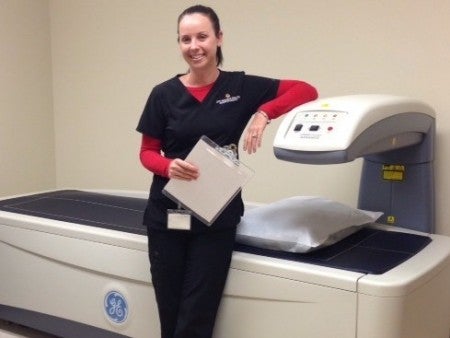“Osteoporosis causes bones to become weak and brittle, and occurs when the creation of new bone tissue doesn’t keep pace with the loss of old bone tissue,” said Shazia Beg, M.D., a board-certified rheumatologist who specializes in the diagnosis and treatment of osteoporosis, sees patients at UCF Pegasus Health and is an assistant professor at the UCF College of Medicine.
Bone loss can happen for a number of reasons, including a lack of estrogen, as seen in post-menopausal women; low calcium intake; anorexia and obesity; a sedentary lifestyle; and genetics. Other risk factors include small stature, Caucasian or Asian race, heavy alcohol consumption and smoking. Osteopenia refers to borderline bone loss and is the condition that precedes osteoporosis.
There are generally no early-stage symptoms of osteoporosis and osteopenia. However, once the bones have been weakened, signs and symptoms may include:
To measure the bone’s strength and presence of the disease, a DEXA scan (or dual energy X-ray absorptiometry) is used to calculate bone mineral density (BMD). Using two x-ray beams of different strengths, the scan measures the amount of x-ray that passes through the bones, which varies depending upon thickness. This information is used to calculate bone density by comparing the differences between the two x-ray beams.
Although osteoporosis affects the entire body, scans are typically focused on the hip and spine; the forearm can be tested in certain situations. Bone mineral density measurements taken at one area of the body are generally predictive of fractures at other areas.
Most women over the age of 65 and men over the age of 70 should receive DEXA scans every two years as part of their regular health maintenance regimen, said Dr. Beg. However, younger patients (men or women) with the following risk factors should speak with their doctors about having the scan:
If bone density is normal and there are no additional risk factors, the DEXA scan can be repeated in 5 years.
Certain medical conditions can cause thinning of the bones, including lupus, psoriatic arthritis, rheumatoid arthritis, kidney disease, hyperparathyroidism (overactive secretion of parathyroid hormone), vitamin D deficiency, hyperthyroidism (overactive thyroid), liver disease and intestinal disease. Those who have undergone chemotherapy also can be at greater risk.
“While osteopenia and osteoporosis are more common in women, one in four men also suffers from the condition,” said Dr. Beg.
DEXA scans take about 10-20 minutes to complete. The procedure is painless, noninvasive and emits less radiation than traditional x-rays.
If you’re a patient at UCF Pegasus Health and fall within the DEXA screening guidelines, call 407-882-4800 to schedule your appointment.
